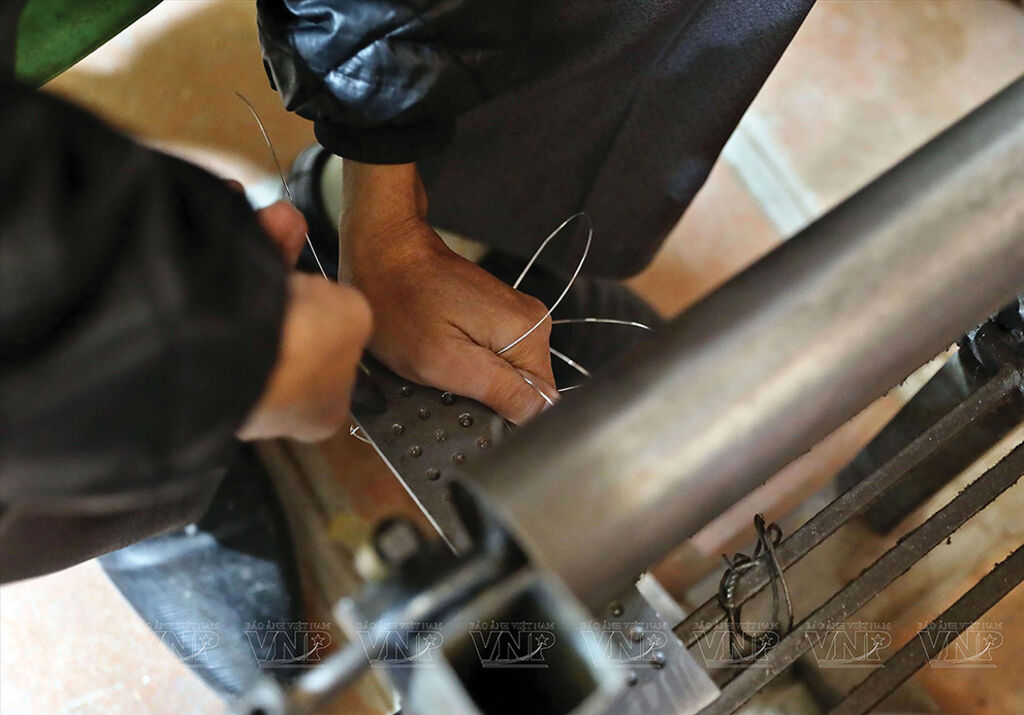 |
| Sketching a design__Photo: VNP/VNA |
Dinh Cong village is the only place in the country specializing in the application of special techniques to make unique intricate silver objects, Hanoi Artisan Quach Phan Tuan Anh, who is also the owner of a jewelry workshop in the village, told the Vietnam Law and Legal Forum magazine.
Dinh Cong silversmithing and jewelry making craft is one of the four quintessential professions in the imperial capital of Thang Long (now Hanoi), alongside silk weaving craft of Yen Thai, pottery craft of Bat Trang village and bronze casting craft of Ngu Xa. The 1,500-year-old village is located on the To Lich river bank in Dinh Cong ward of Hoang Mai district.
Legend has it that the gold and silver jewelry making craft was passed on to Dinh Cong villagers by three Tran siblings at some time between 571-603. After traveling far and wide to learn the profession, they returned home and opened a jewelry store selling elaborate handmade silver and gold jewelry items and taught the craft to other villagers. As time went on, through many ups and downs, with the perseverance, and dedication of local skilled artisans, the traditional silversmithing has been revived passed down, and become a peculiar feature of the millennial city of Hanoi.
 |
| Drawing silver wires through a drawplate into thin, smooth strands__Photo: VNP/VNA |
Exquisite craftsmanship: combination of true artisan’s soul and creativity
According to the village’s experienced silversmiths, it is impossible for workers to create jewelry items with tiny details like Dinh Cong village’s products without creativity and passion for the craft.
There are several techniques that a silversmith must master such as hammering, smoothing, and polishing techniques that are used to make plain jewelry of desired shapes; soldering details of a jewelry piece together; and chasing and repoussé which are the techniques of indenting patterns on the front of the metal and shaping the metal by hammering from the reverse side, respectively.
However, Dinh Cong artisans make a name for themselves as talented silversmiths thanked to a special technique, called “đậu” in Vietnamese, which is the technique of drawing out silver wires into incredibly thin strands and using such strands to make decorative motifs to be soldered in silver products.
 |
| Soldering tiny details together__Photo: VNP/VNA |
The work starts with melting pure silver granules to cast silver bars. Next, the silver bars are passed through nine rolling mill grooves to form wires. These wires are then drawn through a drawplate into smooth, thin strands. The diameter of silver strands will depend on the need of the silversmith. Dinh Cong villagers may make silver strands of a diameter of 0.28mm. Hence, a strand that is hundreds of meters long can be produced from just a 100-gram silver bar. At that stage, the silversmith must keep a very wary eye on his work because any carelessness can make the delicate strands break or tangle. Then every two strands will be twisted into a double-ply threads which will be bent and rolled into various decorative motifs such as animals, flowers, leaves as well as other symbols of a size of a sesame seed, bean or peanut. Finally, motifs of different sizes and shapes are soldered into a silver frame.
Tuan Anh, who has more than 20 years of experiences in the craft, revealed that soldering is the most challenging step in the entire process of making a silver object. Because a product may be composed of hundreds or even thousands of tiny details, overheating can cause damage to these components while insufficient heat can result in loose joints.
 |
| A finished silver flower brooch _Photo: VNP/VNA |
At present, Dinh Cong silversmiths continue to inject their souls into silver works of art. In addition to traditional fine jewelry such as rings, earrings, bracelets and necklaces, they have developed an array of silver paintings which feature iconic images of Hanoi such as Khue Van Pavilion, the Turtle Tower, and the Old Quarter.- (VLLF)









